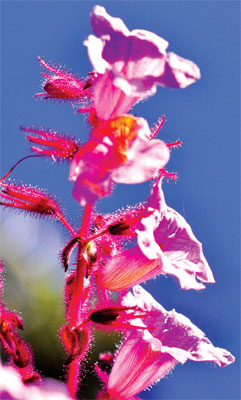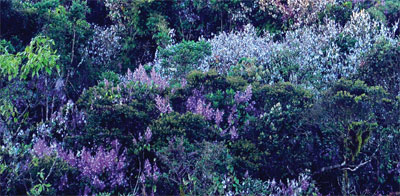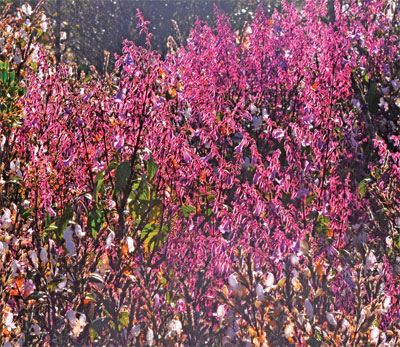The wonder and beauty of the Nelu flower
by Gamini Warushamana
|

Strobilanthes Pulcherrima |
The wonderful environs of the Horton Plains these days are in a flash
of colour with the once-in-twelve year blooming of the Nelu flower. The
entire environs of the Horton plains is reported to be covered with the
blooms.
 |
|

A variety of Nelu fl owers fi lling the environs of Horton
Plains |
The white, pink and purple carpet of Nelu flowers has given an
entirely new dimension to the plains and is said to be a sight to
behold. In a framed portrait of the Nelu flower with a brief description
is displayed at the Pattipola railway station. The picture taken in 2001
by Yomal Perera of Hill Safari gives a brief history of the life cycle
of the plant and its blooming season and has correctly predicted that
the next blooming season between September - December 2013.
So now, from the last week of September and may be continue another
two weeks, the Nelu is in full blossom and you have a limited time to
experience this marvellous wonder of nature.According to Botanists, the
Nelu also called Nilu or Nilla is a plant of Strobilanthes family. There
are around 130 Strobilanthes varieties in the world mainly in the Asian
region. There are 31 species of Strobilanthes in Sri Lanka and of them
26 varieties are endemic to Sri Lanka. In the Horton Plains you can find
eight varieties and seven of them are endemic to the Horton Plains.
Strobilanthes Pulcherrima, Strobilanthes Viscosa, Strobilanthes
Dianadra, Strobilanthes Hookeri, Strobilanthes Sexennies, Strobilanthes
Calycina, Strobilanthes Nockii and Strobilanthes Anecps varieties can be
found in the Horton Plains.
This blossom of Nelu flower is specially important because the flower
blooms in a 12-14 years cycle.
Flowers can be seen along the Pattipola and Ohiya entrances of the
park, in Thotupola Kanda and around Baker's Fall. The Totupola Kanda
area is covered with white, pink and purple carpet of flowers.
It is reported that the biodiversity of Horton Plains has changed
with the flowers in bloom. There are billions of bees and wasps and
their hum of them collecting nectar can be heard all around. The colour
of the plain and the density of insects have also changed. |

